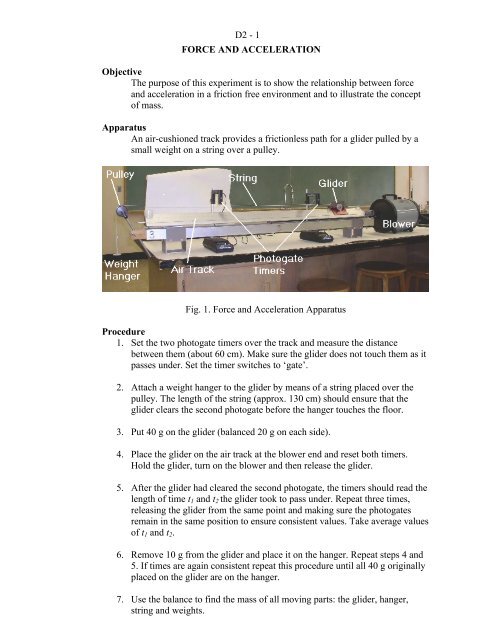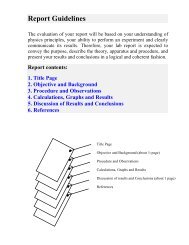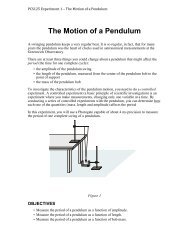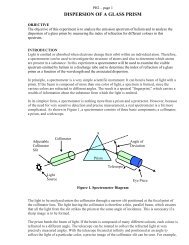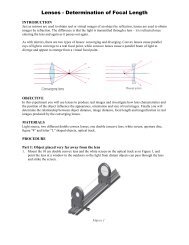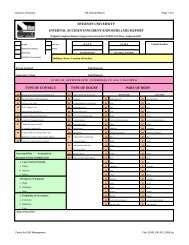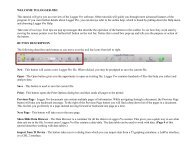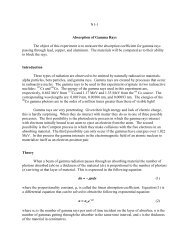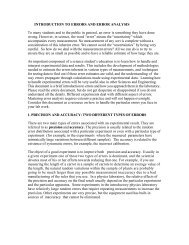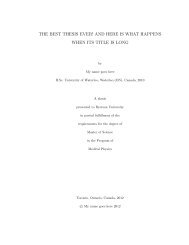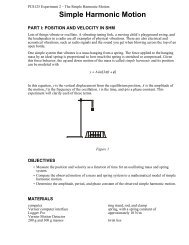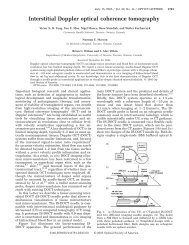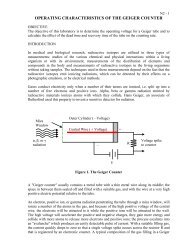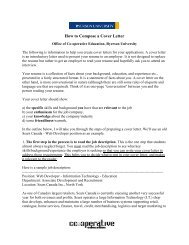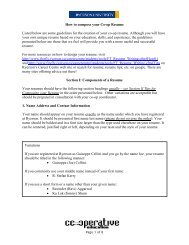Newton's Second Law
Newton's Second Law
Newton's Second Law
You also want an ePaper? Increase the reach of your titles
YUMPU automatically turns print PDFs into web optimized ePapers that Google loves.
D2 - 1<br />
FORCE AND ACCELERATION<br />
Objective<br />
The purpose of this experiment is to show the relationship between force<br />
and acceleration in a friction free environment and to illustrate the concept<br />
of mass.<br />
Apparatus<br />
An air-cushioned track provides a frictionless path for a glider pulled by a<br />
small weight on a string over a pulley.<br />
Fig. 1. Force and Acceleration Apparatus<br />
Procedure<br />
1. Set the two photogate timers over the track and measure the distance<br />
between them (about 60 cm). Make sure the glider does not touch them as it<br />
passes under. Set the timer switches to ‘gate’.<br />
2. Attach a weight hanger to the glider by means of a string placed over the<br />
pulley. The length of the string (approx. 130 cm) should ensure that the<br />
glider clears the second photogate before the hanger touches the floor.<br />
3. Put 40 g on the glider (balanced 20 g on each side).<br />
4. Place the glider on the air track at the blower end and reset both timers.<br />
Hold the glider, turn on the blower and then release the glider.<br />
5. After the glider had cleared the second photogate, the timers should read the<br />
length of time t 1 and t 2 the glider took to pass under. Repeat three times,<br />
releasing the glider from the same point and making sure the photogates<br />
remain in the same position to ensure consistent values. Take average values<br />
of t 1 and t 2 .<br />
6. Remove 10 g from the glider and place it on the hanger. Repeat steps 4 and<br />
5. If times are again consistent repeat this procedure until all 40 g originally<br />
placed on the glider are on the hanger.<br />
7. Use the balance to find the mass of all moving parts: the glider, hanger,<br />
string and weights.
D2 - 2<br />
Calculations<br />
We will use<br />
to find the acceleration for each weight where x is the distance between the<br />
photogates. The velocities v 1 and v 2 are found by dividing the length of the<br />
glider l, by the time t 1 and t 2 respectively, taken to pass under the photogate:<br />
and<br />
The force causing acceleration is given by mg where m (expressed in kg) is<br />
the total mass of the hanger and weights placed on it and g is the<br />
acceleration of gravity (9.8 m/s 2 ).<br />
Results<br />
Plot a graph of acceleration (y-axis) versus force (x-axis). Find the slope of<br />
the best straight line through the points. The value of the slope is the<br />
constant of proportionality between acceleration and force. Compare this<br />
value to the reciprocal of the mass of the glider, hanger and the 40 g masses<br />
as obtained on the balance.<br />
Pre-lab Questions<br />
1. What is the objective of this experiment?<br />
2. Define acceleration.<br />
3. Define force.<br />
4. State Newton’s second law.<br />
5. Is Newton’s second law valid if friction is present? Explain.


